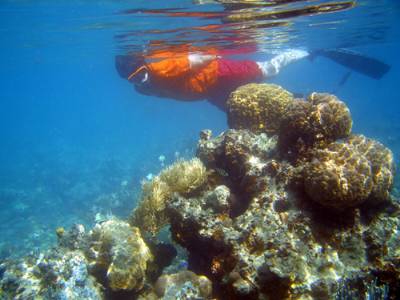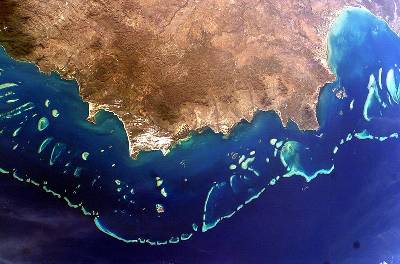Some facts about coral reefs
Online Biology Dictionary
|
|

|
|
Snorkeling a coral reef off Fiji
Image: Masato Ikeda |

|
|
Coral reef off the coast of northeastern Australia (Enlarge image) |

|
| Locations of coral reefs worldwide (Enlarge image) |
Some facts about coral reefs:
-
Coral reefs are large marine structures that generally form in shallow waters. Coral reefs can be hundreds or even thousands of miles long (see lower photo right).
-
Coral reefs are built by innumerable tiny, wormlike animals living in colonies.
-
These animals are known as polyps (pronunciation: "PAWL-ips").
-
Each polyp, typically is only a few millimeters in diameter and a few centimeters long.
-
Though polyps are animals, most corals have photosynthetic algae ("zooxanthellae") that actually live within their tissue and provide them with food derived from solar energy. Such corals must live in shallow water where light levels are sufficiently high.
-
Most corals occur only in shallow tropical and subtropical waters. However, some that lack zooxanthellae do live in deep cold water.
-
Around their mouths, all polyps have a ring of tentacles they use to capture small particles of food. The tentacles contain stinging cells, known as nematocysts, that can kill small animal prey.
-
Although the polyps making up an individual colony are usually genetically identical due to asexual (clonal) reproduction, most corals are also capable of sexual reproduction, which generally occurs at the time of the full moon when gametes are released.
- Each polyp secretes calcium carbonate which fuses together with the secretions of the other members of the colony to form a single rock-hard skeleton containing pits that surround and protect the individual polyps.
Most shared on Macroevolution.net:
Human Origins: Are we hybrids?
On the Origins of New Forms of Life
Mammalian Hybrids
Cat-rabbit Hybrids: Fact or fiction?
Famous Biologists
Dog-cow Hybrids
Georges Cuvier: A Biography
Prothero: A Rebuttal
Branches of Biology
Dog-fox Hybrids